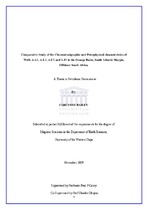| dc.contributor.advisor | Carey, Paul F. | |
| dc.contributor.advisor | Okujeni, Charles | |
| dc.contributor.author | Bailey, Carlynne | |
| dc.contributor.other | Dept. of Earth Science | |
| dc.contributor.other | Faculty of Science | |
| dc.date.accessioned | 2014-01-30T14:19:57Z | |
| dc.date.available | 2010/08/27 10:21 | |
| dc.date.available | 2010/08/27 | |
| dc.date.available | 2014-01-30T14:19:57Z | |
| dc.date.issued | 2009 | |
| dc.identifier.uri | http://hdl.handle.net/11394/2670 | |
| dc.description | Magister Scientiae - MSc | en_US |
| dc.description.abstract | Many hydrocarbon reservoirs are situated in barren sequences that display poor stratigraphic control. Correlation between the wells can become extremely difficult and traditional correlation techniques can prove to be inadequate. Past studies have shown that trace and major element concentrations can be used as a correlation tool. This practice of using geochemical fingerprints to characterize between wells is called Chemostratigraphic analysis. (Pearce et al, 1999) Chemostratigraphy has been recognized as a very important correlation technique as it can be used for rocks of any age, in any geological setting as well as sequences that are traditionally defined as barren. Chemostratigraphic analyses can be used as a means of getting rid of ambiguities within data produced by traditional correlation methods such as Biostratigraphy, Lithostratigraphy and Geophysical Logging. In areas where stratigraphic data is not available it can be used to construct correlation frameworks for the sequences found in the area. The motivation behind this study is that the research is not only worthy of academic investigation, but can also provide the industry with new insights into areas that were previously misunderstood because traditional correlation methods were not adequate. The study area, the Orange basin, is located offshore South Africa and is largely underexplored. The basin, that hosts two gas field namely the Ibhubesi and the Kudu gas fields, has large potential but in the past has not been given due attention with only 34 wells being drilled in the area. The Orange basin has recently been the topic of investigation because of the belief that it may be hosts to more hydrocarbons. This study will utilise Chemostratigraphy to attempt to provide geological information on this relatively under-explored basin. The aim of this research study is to produce a chemostratigraphic framework -scheme for the Orange Basin in order to facilitate reservoir scale interwell correlation. The Objectives of this research study will be to identify chemostratigraphic units or indices, to prove the adequate use of chemostratigraphy as an independent correlation technique and to integrate the chemostratigraphy and petrophysical characteristics of the four wells to facilitate lithological identification. | en_US |
| dc.language.iso | en | en_US |
| dc.publisher | University of the Western Cape | en_US |
| dc.subject | Orange Basin | en_US |
| dc.subject | South Atlantic Margin | en_US |
| dc.subject | Chemostratigraphic modelling | en_US |
| dc.subject | Chemostratigraphic indices | en_US |
| dc.subject | Principal component analysis; | en_US |
| dc.subject | XRF analysis | en_US |
| dc.subject | Well logs | en_US |
| dc.subject | Neutron – density cross plots | en_US |
| dc.subject | M-N plots | en_US |
| dc.subject | Geological correlation | en_US |
| dc.title | Comparative study of the chemostratigraphic and petrophysical characteristics of wells A-A1, A-L1, A-U1 and A-I1 in the Orange Basin, South Atlantic Margin, Offshore South Africa | en_US |
| dc.type | Thesis | en_US |
| dc.rights.holder | University of the Western Cape | en_US |
| dc.description.country | South Africa | |

